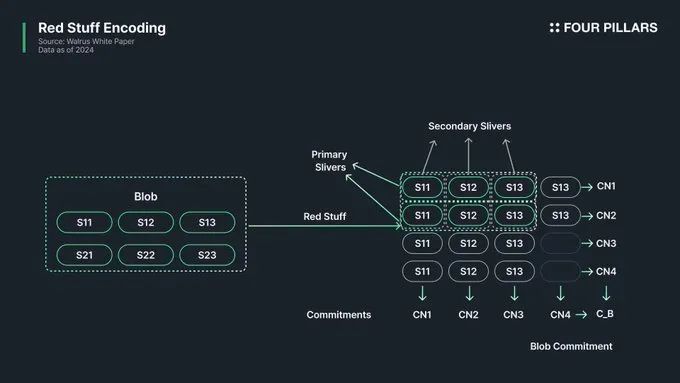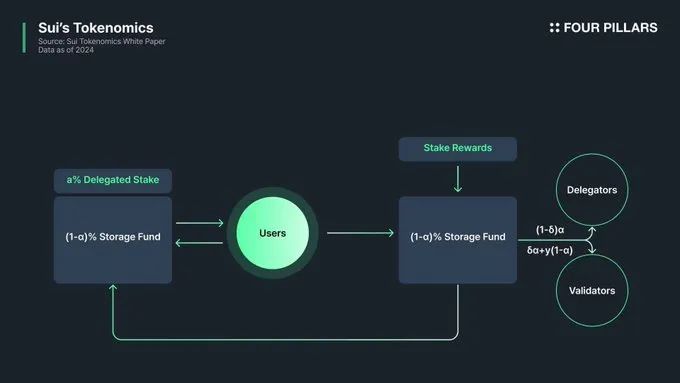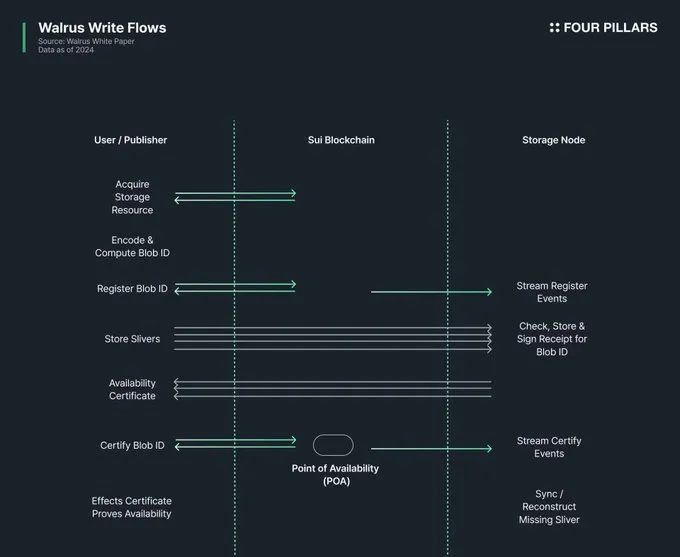This article will explore the structure of the Walrus protocol, analyze its differences from existing decentralized storage solutions, and further study the relationship between Walrus and Sui networks.
The author of this article: @Steve_4P, the article only represents the author’s views.
Summary of key points
– Mysten Labs has successfully launched the Sui Network and DeepBook protocol, and is now preparing to launch a new project-the Walrus protocol.
– Although there are already many agreements in the decentralized storage market, Walrus has attracted widespread attention because of the following two points: (1) Cost effectiveness and security: Walrus is more cost effective and secure than existing storage solutions. (2) Programmability: It enables stored data to be programmed through the Sui network.
– As one of the most advanced projects in existing decentralized storage protocols, Walrus’s practicality and value in the future are very worthy of attention.
01 Background of Walrus launch
Mysten Labs has successfully launched the Sui Network and DeepBook protocol and is now entering a new area-the Walrus protocol. The success of Sui Network and DeepBook has built up a lot of expectations for the Walrus project. However, despite the enthusiasm, there are some doubts surrounding the Walrus agreement.
These doubts stem from several factors: there are many decentralized storage solutions on the market, many of which have not performed as desired; and there are also concerns about resource allocation-especially whether Mysten Labs will decentralize resources to continue to develop and expand the Sui network, affecting the advancement of new projects.
Therefore, we will explore the structure of the Walrus protocol, analyze how it differs from existing decentralized storage solutions, and further study the relationship between Walrus and Sui networks, focusing on how Walrus integrates with the Sui architecture and enhances the value of the entire Sui ecosystem.
1. Differences between Walrus and existing storage solutions
To illustrate why Walrus needs to exist, we first need to discuss how it differs from existing decentralized distributed storage solutions. From my perspective, there are three main differences between Walrus and existing storage models (especially Filecoin and Arweave), which can be summarized as follows:
Storage cost efficiency

First, there are significant differences in storage costs between Walrus, Arweave and Filecoin. As Four Pillars discussed in the Walrus article, Arweave uses a system where all nodes must copy and store all data, while Filecoin allows users to decide how many nodes to store their data (users can choose to store data with only one miner, or distribute 100 pieces of data among 100 miners. Obviously, the more miners are required to store data, the higher the cost).
In contrast, Walrus uses Red-Stuff encoding, demonstrating lower costs than Arweave and Filecoin, with up to 100 times more efficiency (compared to Arweave, which requires network-wide data storage, resulting in up to 500 times more replication costs, while Walrus only needs 4-5 times more replication). At the same time, the probability of data loss is significantly reduced.
Simply put, Walrus solves the shortcomings of Arweave and Filecoin. Although Arweave has a low probability of data loss, replication costs are high; although Filecoin provides relatively cheap storage based on user needs, low-cost options may bring a higher risk of data loss; and Walrus minimizes the probability of data loss while keeping replication costs low, combining the advantages of the two.
In addition, for Arweave, costs increase as the number of nodes increases (although not linearly) because it encourages all nodes/designated nodes to store as much complete data as possible. In contrast, Walrus only requires one network data transmission, and each node stores part of the data, which actually reduces the burden on individual nodes as the network grows. This structural difference makes Walrus significantly more efficient in storage costs than both Arweave and Filecoin.
programmability of
Although Walrus’s efficiency is important compared to Arweave and Filecoin, the most significant difference between it and existing storage models is its “programmability.” Traditional storage is just a simple data warehouse, but Walrus implements programmable decentralized storage through Sui network, giving stored data more functionality.
What if smart contracts could directly reference or trigger data stored in decentralized storage? For example, when casting an NFT, the image file can be stored in Walrus, and its blob data object can be created on the Sui network, connecting it to the NFT object. This solves the “incomplete” problem of traditional NFT (traditional NFT stores tokens on the chain, but NFT’s art metadata is stored off the chain), making NFT via Walrus a true Web3 asset.
Another example directly related to data storage is that since Walrus’s blob data can be stored as Sui objects and controlled through Sui’s Move smart contract, the smart contract can transfer the stored data to other users or automatically change ownership. That’s why we say the data in Walrus is programmable.
In contrast, Arweave and Filecoin have very limited, if not almost impossible, dynamic integration with on-chain applications. Although Filecoin has added some smart contract functions through FVM (Filecoin Virtual Machine), the ability to modify and control data is still limited, and Walrus is significantly superior to these two protocols in terms of programmability.
Data access and deletion
Existing storage protocols have one feature: once data is uploaded, it can be accessed by anyone and cannot be deleted. While this feature may be useful to individual users, it imposes significant limitations on organizations and businesses that need to store sensitive data or need to modify/delete data. In contrast, Walrus allows users to discard or modify their data when needed (unlike Arweave, whose data cannot be deleted or modified; unlike Filecoin, data deletion is not a user’s request, but is deleted when the contract expires or the node hosting the data goes offline).
Some people may worry that this conflicts with blockchain’s immutability principle, but it’s important to keep in mind that what’s deleted in Walrus is blob data. Transaction data unrelated to the deletion of blob data remains unchanged, and deleting blob data will not affect the integrity of the blockchain.
Compared with traditional storage, this enhanced practicality of Walrus has greatly enhanced its application potential in traditional enterprises and Web2 enterprises, further increasing the market’s expectations for its diversity.
2. How Walrus and Sui Network collaborate
After we discuss the differences between Walrus and existing storage protocols, let’s discuss the relationship between Walrus and Sui networks. When Mysten Labs announced it was preparing to launch the Walrus protocol, many people questioned it, arguing that “they should focus on Sui rather than creating a new protocol.” However, if you have a little understanding of how Walrus works, you can clearly see that Walrus is not distracting attention from Sui, but should instead be regarded as a storage stack designed to improve applications on Sui. In other words, Walrus not only supplements Sui Network from a storage perspective, but also actively influences Sui Network’s governance token SUI, which makes the two inseparable. We will discuss this further next.
The symbiotic relationship between Sui and Walrus
In fact, Mysten Labs paid close attention to storage issues in the early design stages of Sui. Blockchain will inevitably grow in use, which may lead to increased transaction fees for Sui network users in the future. Therefore, since Sui’s early design stages, Mysten Labs has proposed a unique storage fund concept to address Sui’s storage challenges.

The Sui Storage Fund operates as follows: The fees submitted by users to the Sui Verification Node are divided into two parts: 1) Gas fees related to calculations, and 2) storage fees for data storage. Sui charges storage fees in advance when users upload data and transfers these funds to the storage fund. The Storage Foundation continues to allocate these funds to verification nodes while the data is stored on the chain. In addition, if users delete data, they can receive a refund for storage fees.
Sui’s unique on-chain data storage system has two effects:
- Users can get a refund for storage fees when deleting data on the chain, creating a financial incentive to reduce the capacity of the distributed ledger.
- The system solves storage-related sustainability issues by charging storage fees in advance and using them as a reward for future verification nodes.
Although Sui solves sustainability issues with this unique structure, storing large-scale blobs of data, such as media files, on the chain remains a burden. At this time, Walrus came into play-by storing large-scale blob data and object-managing its metadata on Sui, the data can be programmable without being directly stored on Sui.

In addition, Walrus uses Sui to implement the most distinctive feature compared to other storage protocols-making stored data programmable and controllable. In the end, Sui and Walrus established a symbiotic relationship, in which the two sides made up for each other’s shortcomings and created unique advantages.
Walrus makes SUI a deflationary asset
From the example of storing funds, we can see that the Sui network requires a certain amount of SUI to be paid as a storage fee for storing any object, and Walrus is no exception. When creating a blob data object in Walrus, SUI will be locked in the storage fund based on the size of the object (which refers to the object size that represents the blob, not the actual size of the blob).
Although some fees can be refunded by deleting data, some fees will have a destructive effect, reducing circulation by permanently removing tokens. In other words, the more data is stored through Walrus, the more SUI will be permanently locked in the storage fund, forming a virtuous cycle where increased use of Walrus leads to a decrease in the circulation of SUI.
In summary, the emergence of Walrus is positive news for Sui Network, both at the network level and at the asset level. It is expected that through Walrus, Sui ecology will develop in a more diversified direction.
02 Walrus will become Sui’s most critical agreement
1. Not just building a blockchain
When Mysten Labs was first founded, I thought it was just a company focused on Sui Networks. However, after seeing the launch of services like Deepbook and SuiNS, I started thinking about what kind of vision Mysten Labs was pursuing. When I met Walrus, I realized their goal was to build a complete decentralized infrastructure for Web3.
Compared to other companies, Mysten Labs views the industry with a different time horizon. They are not just issuing tokens, creating popularity and quickly monetizing; instead, they have a vision to lead innovation in various areas such as execution, storage, consensus and communication, while understanding users ‘inertia towards Web2 services and creating the most suitable UI for them.
Sui Network processes execution and consensus (evolving through initiatives like Mysticeti, Pilotfish, and Remora), storage is handled by Walrus, communications is handled by SCION (a next-generation Internet architecture that protects network packets, known for its Anti-DDoS protection and immune routing attacks-note that SCION was not created by Mysten Labs, but it will be used in Sui Networks), and Web2’s familiar UI is managed by zkLogin, Stashed, SEAL, and KELP.
If these plans are successfully implemented, I believe that Mysten Labs can rewrite the existing Web3 paradigm. My original ideas were limited, and Mysten Labs didn’t just want to build a blockchain-they were a team building the infrastructure for a new network. Of course, I think Sui is at the heart of Mysten Labs ‘vision, and other initiatives are complementary. The same goes for Walrus, which in my opinion is probably the most important agreement.
2. Walrus is not limited to Sui Ecology
However, Walrus is not limited to Sui Ecology. Like other storage protocols, Walrus can be used by any third party, not just Sui apps, it may even serve as a powerful alternative to existing storage protocols, or as an alternative to other DA layers such as Celestia, EigenDA, Avail.
This availability of Walrus extends the needs of SUI beyond the Sui network. When Walrus is used, data objects are created on the Sui network, resulting in reduced SUI circulation. In other words, Walrus has the potential to make SUI a more attractive asset by creating external demand (this is not investment advice, but a structurally possible scenario). As a result, Walrus is expected to serve as a bridge, extending Sui in all directions.
3. Can Walrus surpass Filecoin?
Although caution is needed when comparing the value of specific protocols, I am very optimistic about Walrus’s future because: 1) its operating mechanism is far more efficient than existing storage protocols, 2) it can perform tasks that existing storage protocols cannot do (such as becoming a DA or making storage data programmable), and 3) it already has a solid network and user base through the Sui Network.
If Walrus is not just the storage layer of the Sui Network, but becomes the representative storage protocol of Web3, as Mysten Labs envisions, it has the potential to become the leading protocol in the storage space.
原文链接



